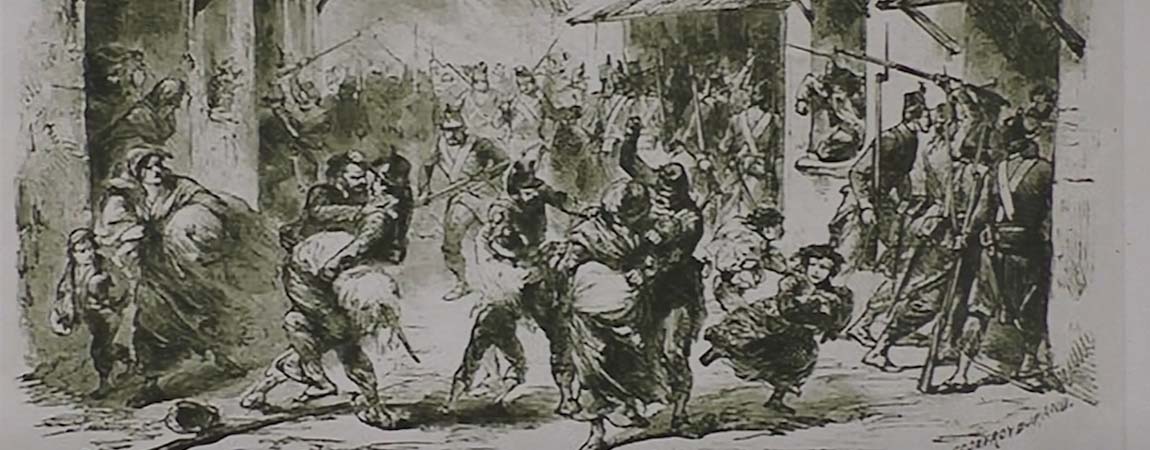
In 1866 Adrano, a town in eastern Sicily, currently in the province of Catania, had, like Milan, its fateful five days.
However, while the Lombard uprisings had as their objective independence from Austrian domination, the popular revolt of Adrano took place in Unity of Italy already done. An extremely difficult historical context, the post-unification one, for the whole of the south and, in particular, for Sicily.
Sicily's aversion to the new kingdom
The year of the Adrano riots was a very unfortunate year for the newly established company Kingdom of Italy which had unified the peninsula just five years ago.
There was, in fact, a dramatic cholera epidemic which shocked the country from north to south, causing countless victims. Furthermore, Austria was fought again and in Palermo the separatist ambitions of the island resulted in a real revolution.
In Sicily, after unification, the reality of the facts and the conditions of the people were such as to arouse a profound aversion towards the kingdom on the part of all social sectors.
In fact, it was not only the poor who were dissatisfied. The ecclesiastical class had not appreciated the expropriation of the properties of the convents; the bourgeoisie did not look favorably on the high taxes and the humble citizens suffered from the scarcity of work and from being forced to perform military service which took them away from the fields or small craft shops.
In a song in vogue at the time there was talk of a Paper Sicily whose precious materials had vanished into thin air after the proclamation of the unity of the Italian state.
1866: the year of cholera
The population, incited by followers of the Bourbons and the clergy, was in turmoil. The fuse that exploded the protest was precisely the cholera that arrived on the island in September 1866.
In fact, it was believed that the epidemic was to be attributed to the Piedmontese who, through the horrible evil, had the intention of suppressing a large part of the Sicilians to get rid of them and enrich themselves with inheritance taxes.
What was only a rumor of the people soon assumed the value of truth and spread very quickly. In fact, the people had no doubts that the Piedmontese conquerors had committed such an atrocity.
On the other hand, the cruel acts they had committed demonstrated that they were capable of anything. To combat the resistance to military service, they had, for example, set fire to entire families, besieged and thirsted many inhabited centers and carried out barbaric actions such as the 154 burns inflicted on a young deaf-mute from Palermo, unjustly suspected, of pretending to be unfit for military service.
The half-past seven revolt and the five days of Adernò
When cholera arrived, after many aberrations, the population of Palermo reacted with an insurrection that lasted a week and a half (from 16 to 22 September): hence the name revolt of half past seven.
From the capital, the revolutionary fire spread to Adernò, ancient name of adrano (maintained until 1929). The riot lasted less than Palermo: only 5 days, from 28 September to 2 October.
The events of those epic days were narrated in a booklet by Benedetto Guzzardi Moncada, patriot who had participated in the landing of the Thousand and that Garibaldi he used to call hisbeautiful blonde angel".
In his report, Guzzardi declares himself a defender of Adernò, praising the city's deeds and denying those who defined it as uncivilized. There Adrano riot, according to the baron, was not the work of criminals: the brigands who had risen were not criminals, but honest young patriots.
Adrano: the insurrection placated by force
The revolt broke out on September 28th when the population Adranese for the reasons already mentioned (cholera and the rumor that it was the government that had spread the disease to pocket the inheritance taxes of the victims) and at the urging of young men who did not want to do military service, it poured en masse into the streets .
The authorities defined the action of the rioters as a wicked looting. He immediately mobilized there Local National Guard and, already the next day, to counter the revolt, from Catania, two entire infantry companies under the orders of Captain Luigi Gabriele Pessina poured into Adrano.
The anger of the people, however, did not subside even when the reinforcements arrived, despite the attempted pacification of the Baron Filadelfo Ciancio. Those who could abandoned Adrano to seek refuge from the clashes in the countryside.
The climax of the revolt was due to strange fireworks that lit up the night of Adrano and due to the increase in the number of deaths from cholera. The rioters even tried to lynch two alleged infectors. The riots ended bitterly on October 2, at two in the afternoon, five days after the beginning, when the infantry led by Pessina dispersed the people who crowded the streets.
The reprisal in the five days of Adrano
The authorities were not satisfied with placating the revolt by force, but inflicted cruel reprisals on the population.
Three young people from the same family they were executed, due to a tragic mistake, by the soldiers regardless of the young age of the minor of just 15 years and of the role of peacemaker that another of the Crucillá brothers he had tried to perform on the basis of his membership in the National Guard.
The same account as Baron Guzzardi he was questioned by an Adranese doctor who accused him of having left the country already September 30th and that, having cowardly abandoned the field, he could not have the knowledge of the facts which, instead, he flaunted in his pamphlet.









